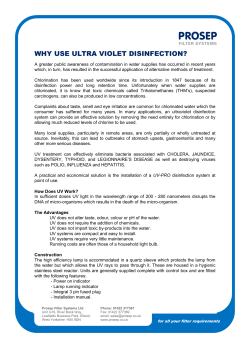
Disinfection Guideline for Bulk Water Haulers
Disinfection Guideline for Bulk Water Haulers General In order to maintain the safety of the drinking water, operators of bulk water hauling vehicles must ensure that: the water is protected from contamination during filling, storage, transportation and delivery. It is important that the equipment is cleaned and disinfected regularly; and, the water to be hauled is obtained from a municipal water supply or from a supply approved by the local regional health authority. Steps 1. Follow the chlorine manufacturer’s instructions for use. Undiluted chlorine may be dangerous. Avoid contact with skin, inhaling the fumes and wear protective clothing/eye wear. 2. Ensure that there is proper ventilation during the chlorination procedure. 3. Slowly add the amount of chlorine (unscented bleach) indicated in Table 1 directly to the tank after filling. TABLE 1 Size of Tank Disinfection during Transport Note: This procedure is only sufficient when hauling from a treated source. Chlorine should be added to the water in the tank in an amount sufficient to achieve 1.0 mg/L of total chlorine at the time of filling. This will help to ensure the water remains potable at the point of delivery. The free chlorine residual at the point of delivery should be at least 0.1 mg/L of free chlorine. This should be confirmed by testing. Materials Required Chlorination should be performed using unscented household bleach. Caution: "all purpose bleaches" (such as Javex 2) contain no chlorine and should not be used for water chlorination and disinfecting tanks. Table 1 outlines the quantity of bleach required to properly sanitize tanks of various sizes. Imperial Gallons 500 1,000 1,500 2,000 2,500 3,000 Litres 2,270 4,540 6,810 9,080 11,350 13,620 Amount of 5.25% Unscented Bleach required to produce approximately 1.0 mg/L total chlorine. Fluid Millilitres ounces 1.5 45 3 90 4.5 130 6 175 7.5 220 10 260 Shock Disinfection Procedure Periodic shock chlorination of the water hauling tank is recommended. In addition, if a tank has contained untreated or raw water, the tank should be disinfected. The following outlines recommended disinfection procedures for pre-cleaned tanks used for hauling drinking water: 1. Disconnect or remove all water treatment equipment such as water filters and softeners from the drinking water tank. 2. Fill the tank to at least half of its total capacity with potable water ensuring that space remains for the chlorine added in Step 3. Water 3. Add chlorine to the tank to achieve 20 mg/L of total chlorine in the tank when full. If using unscented household bleach (5.25% sodium hypochlorite), add 400 ml (13 fl. on.) of unscented household bleach into the tank for every 1000 L (220 imp gal.) of tank total volume. Alternatively, if using industrial strength sodium hypochlorite (12%), add 200 ml (6 fl. on.) into the water tank for each 1000 L (220 imp gal.) of water tank total volume. 4. Fill the water tank to its maximum holding capacity with potable water. 5. Disinfect the associated piping and equipment by pumping the chlorinated water into the piping and then opening each tap and running the water until you can smell the chlorine. Do not run chlorinated water through certain types of water treatment equipment (e.g., softeners, carbon filters, reverse osmosis systems). For specific information, contact your treatment equipment dealer. 6. Leave the chlorinated water in the tank and in the associated piping and equipment for a minimum of 24 hours to allow adequate time for disinfection. Water MUST NOT BE CONSUMED during this process, as it will contain high levels of chlorine that are unsafe for consumption. 7. After disinfection, drain the chlorinated water from the tank and associated piping and equipment, and thoroughly rinse the system with drinking water. 8. Dispose of the heavily chlorinated water and rinse water appropriately. The drinking water used to refill the drinking water tank should be of an acceptable bacteriological quality before the tank is used again. TABLE 2 Size of Tank Imperial Gallons 500 1,000 1,500 2,000 2,500 3,000 Litres 2,270 4,540 6,810 9,080 11,350 13,620 Amount of unscented household bleach required to produce 20.0 mg/L total chlorine Fluid Millilitres Ounces (Litres) 30 900 (0.9L) 61 1700 (1.7L) 91 2600 (2.6L) 122 3500 (3.5L) 152 4300 (4.3L) 183 5200 (5.2L) Disposing of Heavily Chlorinated Water Do not dispose of rinse water or heavily chlorinated water in an onsite wastewater treatment system. Consult regulatory authorities for acceptable disposal options of significant volumes (i.e. more than residential use) of highly chlorinated water. Additional information can be obtained from: Further information on drinking water can be accessed at the Government of Saskatchewan’s website (www.saskh2o.ca). The link below provides the contact information for public health officers throughout the province: http://www.saskatchewan.ca/live/health-andhealthy-living/provincial-healthsystem/saskatchewan-health-regions/regional-publichealth-inspectors
© Copyright 2025










